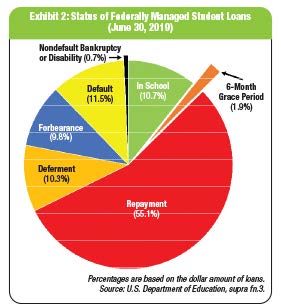CHAPTER 6, B. Game of Loans: Is Student Debt Forgiveness Coming?
| Jurisdiction | United States |
B. Game of Loans: Is Student Debt Forgiveness Coming?
ABI Journal
December 2019
Ed Flynn
ABI
Alexandria, Va.
Much ink has been spilled in recent years detailing the student loan crisis. This article examines some of the numbers behind the issue and discusses possible solutions.
How Much Is Owed?
This seems like a fairly straightforward question, but it is actually difficult to pin down. The Federal Reserve compiles two different figures for student loan debt. The St. Louis Federal Reserve, which gets information from lenders, reports that total student loan debt was $1.61 trillion as of June 30, 2019.1 The New York Federal Reserve reports the figure at $1.48 trillion based on data from credit agencies.2 The Department of Education's student loan data (which excludes private loans) is somewhere in the middle of the two Federal Reserve figures.3 Whatever the actual amount owed, it is huge — far exceeding outstanding auto loans and credit card debt. None of this debt is currently dischargeable in bankruptcy, except in rare circumstances.
How Has It Grown Over Time?
There are a variety of repayment options available to student loan borrowers.4 Nevertheless, total student loan debt has been increasing by $70 billion to $100 billion per year since 2006. During the same period, total federal and private student loans granted averaged only $105 billion per year, which means that repayments during that time have barely covered interest and penalties. In fact, since 1970, slightly more than $2 trillion in student loans have been lent out.5 Therefore, the amount currently owed is around 75-80 percent of the total originated since 1970 (see Exhibit 1).

How Many People Have Student Loan Debt?
The New York Federal Reserve reports that 44.7 million Americans have student loan debt.6 Data from the Bureau of the Census indicates that there are about 254 million people aged 18 or older in the U.S.,7 so 17.6 percent of American adults have student loan debt.
What Is the Status of These Loans?
There are seven major status categories for federally managed student loans. No repayment is necessary while the borrower is in school or for a six-month grace period after exiting school. Deferment includes loans in which payments have been postponed for reasons such as returning to school, military service or economic hardship. Forbearance covers loans in which payments have been postponed due to a financial hardship. Default includes loans that are more than 360 days delinquent. There is also a special category for loans that are in nondefaulted bankruptcy or in a disability status. All other loans are considered to be in active repayment status. A little more than one-half of student loan debt is in this category.
What Is the Default Rate?
Exhibit 2 shows that the reported default rate for federally managed loans is 11.5 percent. However, since no payment is currently expected for about one-third of the loans, the true default rate is actually more than 17 percent.
This exhibit does not include private student loans (current balance is approximately $123 billion). Repayment rates are quite high for private student loans. About 90 percent of them have a co-signor, and less than 2 percent of these loans are more than 90 days overdue.8

Has Congress Taken Any Action?
On May 9, 2019, the Student Borrower Bankruptcy Relief Act of 2019 was introduced in the House (H.R. 2648) and in the Senate (S. 1414).9 It would make all student loan debt dischargeable in bankruptcy. The Senate bill has been referred to the Committee on the Judiciary, while the House bill has been referred to the Subcommittee on Antitrust, Commercial and Administrative Law.
What Are the Positions of the Democratic Presidential Candidates on Student Loans?
Two of the leading Democratic contenders have proposed rather dramatic plans to forgive some or all student loan debt. A plan by Sen. Bernie Sanders (I-Vt.) includes complete forgiveness of all federal student loan debt and forgiveness of private student loan debt upon request.10 The immediate cost would be $1.5 trillion to $1.6 trillion (not counting other provisions in the proposal). This plan would likely result in a further decline in bankruptcy filings, as a significant number of debtors have student loan debt along with the debt they are trying to discharge through bankruptcy.
A proposal by Sen. Elizabeth Warren (D-Mass.) includes forgiving up to $50,000 in debt for each borrower, subject to rather liberal income limits. Plus, private loans can be converted to federal loans. In addition, any debt that is not forgiven would be dischargeable in bankruptcy.11 Her position paper notes that "[e]xperts estimate [that] my debt-cancellation plan creates a one-time cost to the government of $640 billion."12 Other leading candidates have agreed that student loan debt is a problem, but have more restrictive or less...
To continue reading
Request your trial
